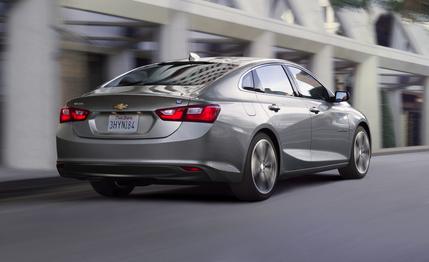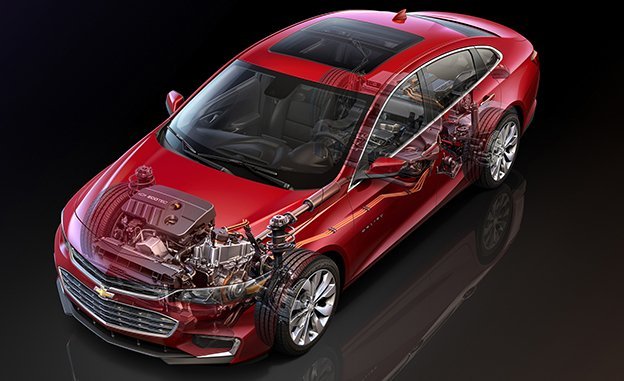
 First Drive Review
First Drive Review
Tell anyone that the new Chevy Malibu hybrid shares much of its powertrain with the Volt and they’ll inevitably ask how far it can go in EV mode. Answer: not far. Unlike the Volt, the Malibu hybrid is set up to maximize fuel economy from a running engine, not to stretch electric range. Wait till you tell them you can’t even plug it in.
Instead, there’s this: 48 mpg city and 45 highway. Those EPA numbers are high enough to beat the hybrid versions of the Ford Fusion, Hyundai Sonata, Kia Optima, and Toyota Camry. It might not beat the Honda Accord hybrid’s 50/45 figures, but that car is on hiatus till 2017 as production moves to Japan.
Pulled directly from the Volt are the two electric motors, the transmission, and the regenerative-braking system. There are two major differences, however: the engine and the battery. Under the aluminum hood is a 122-hp 1.8-liter four-cylinder instead of the Volt’s 101-hp 1.5-liter four. GM deemed a larger engine necessary because the Malibu relies on its gas burner more often, the battery pack being a mere fraction of the Volt’s. The Malibu’s 1.5-kWh battery packs in the trunk and eats about as much space as a roller-bag suitcase; the Volt has a bulky 18.4-kWh pack running up its spine.
Tucked just behind the rear seats, the Malibu’s battery reduces trunk volume from 15.8 cubic feet to 11.6. And while the rear seats still fold, the battery mostly blocks the pass-through. Hybrid hardware isn’t light, either. The hybrid weighs 371 pounds more than a base Malibu with the 1.5-liter engine.


There’s not much EV range to be had with a 1.5-kWh battery, which is why the Malibu isn’t designed to operate in EV mode for very long or at speeds above 55 mph. Instead, it works just like a Toyota Prius, typically motoring off on electric power but firing up the gas engine soon after to work with the electric motors to move the car forward in the most efficient manner possible.
There’s no EV-mode button to lock it into electric drive—or any other setting. Chevy claims that it’s already set up for maximum efficiency and driver input isn’t necessary. Being light enough on the throttle to stay in EV mode up to any significant speed is challenging, although a digital display is there to help, informing the driver how deep the accelerator can go before it fires the engine.
When the engine kicks on, it does so quietly and without much vibration. Under moderate to hard acceleration, the hybrid system feels and sounds a lot like a conventional sedan with a CVT. The system holds engine revs at a constant rpm, and the car surges forward without gearshifts or changes in pitch. From a stop, the acceleration to 40 or so mph comes with a strong shove and wheelspin, the electric motor’s 277 pound-feet of torque hitting hard and fast. In a passing situation, the electric motor boosts the gas engine with a satisfying surge.

 2016 Chevrolet Malibu hybrid lithium-ion battery system
2016 Chevrolet Malibu hybrid lithium-ion battery system
Lifting off the accelerator sends some charge back to the battery. Apply the brakes gently to increase the electrical regeneration, or select L1 or L2 on the gear shifter to increase the amount of resistance from the motor. Borrowed from the Volt, the Malibu’s braking system seamlessly blends the braking done by the motor-turned-generator and the disc brakes. They feel linear and normal, which can’t be said of many other hybrids.
Visually, there are a few subtle tweaks to reduce drag, such as additional radiator shutters and a slightly lower ride height. Otherwise, the Malibu hybrid is a dead ringer for the conventional model. Even the tires are the same; no rock-hard, low-rolling-resistance rubber or 45-psi pressures here.
Chevy hasn’t announced pricing, but when the hybrid arrives this spring, we’d guess it’ll add about $2000 to the bottom line of a Malibu 1LT. So expect prices to open at $28,000 for a base version. What buyers will get is a normal Malibu with the soul of a Volt, the space of a mid-size sedan, and nearly the fuel economy of the outgoing Prius. That’s worth crowing about.